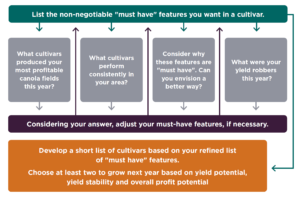Do you want the best? Or the best for you?
With all the choices canola growers make in a season, decision fatigue can set in when it comes to seed selection. To keep it simple, farms often stick with what worked last year. But is that the best choice? Could farms be leaving profit on the table? Our simple decision tree can make the decision process more refined and less tiresome.

Decision tree, step by step
Step 1. List your “must have” traits
Write down the traits essential to your system. These could be herbicide tolerance, days to maturity, pod shatter tolerance, specialty oils, disease resistance and others. The section below describes
each option.
Step 2. Calculate which cultivars produced your most profitable canola fields this year
Look at yield, quality, seed prices, in-season input requirements, harvestability, fertilizer use efficiency and any other factors that influence profitability and the overall growing experience. Can you pin higher profitability on any specific features related to seed or seed treatment? Change your “must have” list accordingly.
Step 3. Look beyond the current year and beyond
the farm gate
Some cultivars yield consistently at or near the top in any conditions. Review results over the past few years on your farm. Ask neighbours and local seed suppliers for their thoughts. Check seed company trial results. Change your “must have” list accordingly.
Step 4. Critically examine your “must have” list
Try to envision a better way to grow canola. Think about what other farmers are doing, what local research organizations have shown, what end users are buying, and for what price. Honestly evaluate your system. Change your “must have” list accordingly.
Step 5. Note the top yield robbers on the farm
If certain pests, such as blackleg, clubroot and flea beetles, consistently reduce canola yield on the farm, look at new sources of resistance and seed treatments to manage those pests. If drought or heat were big yield robbers, ask seed companies if they have cultivars that seem to perform better under these environmental stresses. Change your “must have” list accordingly.
Step 6. Develop a short list
Use your refined list of “must have” features to create a short list of cultivars. Choose at least two to grow next
year based on yield potential, yield stability and overall profit potential.
For the complete version of this article, including valuable links, please read “Choose the right cultivar for each field” in the Plant Establishment section here.
Common canola traits
Disease resistance
- Clubroot resistance. As clubroot populations become more diverse in fields, and as seed companies release new resistance genes, farms may see a benefit in rotating resistance sources.
- Blackleg resistance. In fields with yield-robbing levels of blackleg, use cultivars with a blackleg resistance group (RG) that works against the common blackleg races in that field. A stubble test will identify the dominant blackleg races in a field and provide tips for RG selection.
- Other disease resistance. Some cultivars may have higher verticillium tolerance than others, but no verticillium stripe resistance rating system exists for canola. Some cultivars may also have higher levels of sclerotinia stem rot tolerance. Ask seed companies.
Pod shatter resistance
The official canola shatter ratings of 1-9 represent a cultivar’s pod shatter risk relative to designated checks. The higher the number, the greater the pod shatter resistance. Cultivars with pod shatter tolerance are better suited to late swathing and straight combining, which can improve yield and provide more flexibility on harvest timing.
Days to maturity
Cultivars with shorter days to maturity could be more profitable on fields often seeded late because of drainage issues, in the Brown soil zone where intense summer heat can reduce yields, and as a strategy to spread out harvest.
Herbicide tolerance system
What herbicide tolerance (HT) system best controls the major weeds in each field and best meets the whole-rotation needs of the farm? Cultivars stacked with both glyphosate and glufosinate tolerance can be particularly effective on wild oats. Farmers who list glyphosate tolerance as a must-have trait and who also have glyphosate-resistant kochia may consider a cultivar with stacked HT systems.
Specialty markets
Cultivars with specialty oils provide a different marketing opportunity along with premiums, specified delivery dates and on-farm pick up.
Other considerations
- Seed treatment. Getting the greatest value from seed treatment will require some thought about field histories for insects and disease.
- Lodging score. If you want to increase nitrogen rates, consider cultivars with high lodging resistance.
- Weather resilience. Seed companies may have insight into which cultivars perform best in low moisture, high moisture, high heat and other weather scenarios you often encounter.
Bottom line: Grow more than one cultivar
Growers often want to experiment with at least one new cultivar each year. Rather than put that cultivar in its own field, consider seeding a block through the middle of a field of the farm’s current favourite cultivar. That way the two cultivars get a head to head test in the same field with the same soil type, weather and field history.
If a farm grows only one canola cultivar and has an issue with performance, they may not be able to determine whether a different set of genetics might have helped in their scenario. With two or more cultivars, performance can be compared and analyzed.
Tip for an easy trial
Growers often want to experiment with at least one new cultivar
each year. Rather than put that cultivar in its own field, consider
seeding a block through the middle of a field of the farm’s
current favourite cultivar. That way the two cultivars get a head
to head test in the same field with the same soil type, weather
and field history.
Through this process, farms do their own phenotyping to analyze
genetic performance based on local growing conditions.




